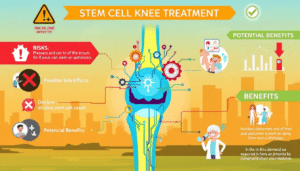Aging research delves into the molecular mechanisms underlying the inevitable biological process affecting all organisms. The quest to decipher these mechanisms has intensified, driven by the aspiration to mitigate age-related decline and diseases. Research on stem cells for aging process reversal seems to be proving to offer valuable, noticeable results for patients around the world.
Stem cell antiaging technology has emerged as a focal point in this endeavor, offering promising avenues for intervention. Among the diverse types of stem cells under investigation, primitive mesenchymal stem cells, including mesenchymal stem cells derived from adipose tissue and induced pluripotent stem cells, have garnered considerable attention.
These cells hold immense potential for rejuvenating aging tissues and organs, offering hope for combating age-related decline. While they cannot “reverse aging” per se, aging-related diseases may be addressed with stem cells. Additionally, stem cells for anti-aging are showing tremendous potential as a form of outpatient regenerative medicine.
Stem Cells for Anti-Aging

While the field of stem cell antiaging research is still in its infancy, studies using mouse embryonic bone marrow mesenchymal stem cells have provided valuable insights into the mechanisms underlying aging and the potential of stem cell therapy. However, significant challenges remain, including safety concerns, ethical considerations, and the need for rigorous clinical trials.
In this article, we delve into the burgeoning field of stem cells for aging, exploring the current state of research, the challenges and opportunities ahead, and the potential implications for promoting healthy aging and enhancing the quality of life for aging populations.
Through a comprehensive examination of stem cell antiaging technology, we aim to shed light on its promise and limitations in the quest to defy the effects of time.
Exploring the Potential of Stem Cells in Combating Age-Related Decline

Stem cells offer promise in combating age-related decline by their unique ability to regenerate and rejuvenate aging tissues. This potential stems from their capacity for self-renewal and differentiation into specialized cell types.
While still in the early stages, research on stem cell therapy for aging shows promising findings in reversing age-related damage and enhancing overall health span. Stem cells target underlying cellular and molecular mechanisms of aging to restore tissue function and improve organ health.
Despite the challenges, including safety concerns and ethical considerations, stem cell therapy holds potential for addressing age-related decline.
Current research explores various types of stem cells, including primitive mesenchymal stem cells and induced pluripotent stem cells, for their anti-aging properties. Through innovative approaches, stem cell therapy aims to improve the quality of life for aging populations and promote healthy aging.
Understanding the potential of stem cells in promoting healthy aging is crucial for addressing the challenges of aging and improving overall well-being. As research progresses, stem cell therapy may offer new avenues for combating age-related diseases and enhancing longevity.
Continued exploration and translation of stem cell research into clinical practice hold promise for revolutionizing the field of aging and extending health span.
Can You Reverse Aging and Its Biological Process?

Aging refers to the gradual, progressive decline in physiological function and the increased susceptibility to age-related diseases that occur over time. It is a complex biological process influenced by a combination of genetic, environmental, and lifestyle factors.
At the cellular level, aging is characterized by a variety of changes, including alterations in DNA repair mechanisms, accumulation of cellular damage, and dysfunction of organelles such as mitochondria.
These changes lead to a decline in tissue and organ function, resulting in a range of age-related conditions such as cognitive decline, cardiovascular disease, and osteoporosis.
While aging is a natural part of life, understanding its underlying biological processes is crucial for developing interventions to promote healthy aging and improve the quality of life in older adults. Natural stem cell transplantation may help address aging-related diseases and restore cell and tissue functions. Additionally, stem cell treatments may work well as an anti-aging tool.
Adipose-Derived Stem Cells Vs. Mesenchymal Stem Cells

Adipose-derived stem cells (ADSCs) are a type of mesenchymal stem cell (MSC) found within adipose (fat) tissue. These stem cells are abundant and easily accessible, making them an attractive source for regenerative medicine and tissue engineering applications.
SCs are adult stem cells that have self-renewal, immunomodulatory, anti-inflammatory, signaling, cell division, and differentiation properties. The study found that inducing old human cells in a lab dish to briefly express these proteins rewinds many of the molecular hallmarks of aging and renders the treated cells nearly indistinguishable from their younger counterparts
The paracrine effect of ADMSCs is particularly significant, as they can secrete various cell growth factors and chemokines, thus promoting angiogenesis, stimulating the activation of endogenous SCs, regulating inflammation, and promoting wound healing.
Cell Division and Self-Renewal
During our life, the self-renewing capacities of our body naturally decline. This happens because the amount of stem cells in our body gradually decreases, and the ability of our stem cells to multiply and replace aging cells with new ones diminishes over time. Human heart cells developed from human skin cells, beating in a dish.
his article delves into how stem cell treatments, alongside anti-aging genes, can significantly slow down aging and enhance overall health and lifespan. Neural stem cells derived from primitive mesenchymal stem cells reversed disease symptoms and promoted neurogenesis in an experimental autoimmune encephalomyelitis mouse model of multiple sclerosis.
Factors Contributing to Aging: Genetics, Lifestyle, and Environmental Influences

Aging is influenced by a multitude of factors, including genetics, lifestyle choices, and environmental influences. According to aging research, here’s how each contributes to the aging process:
Genetics
Genetic factors play a significant role in determining an individual’s susceptibility to aging-related changes and diseases. Variations in genes can affect the rate of aging and the likelihood of developing age-related conditions such as Alzheimer’s disease, cardiovascular disease, and cancer.
While genetics can predispose individuals to certain conditions, lifestyle and environmental factors often interact with genetic predispositions to influence the aging process.
Lifestyle Choices
Lifestyle choices such as diet, exercise, and stress management can profoundly impact the aging process. Poor dietary habits, such as excessive consumption of processed foods and sugar, can contribute to inflammation, oxidative stress, and accelerated aging.
Regular physical activity has been shown to promote healthy aging by improving cardiovascular health, maintaining muscle mass and strength, and reducing the risk of chronic diseases.
Effective stress management techniques, such as mindfulness meditation and relaxation exercises, can help reduce the impact of chronic stress on the body and slow down the aging process.
Environmental Influences
Environmental factors, including exposure to pollutants, toxins, and ultraviolet (UV) radiation, can accelerate aging by damaging cells and tissues. Air pollution, cigarette smoke, and industrial chemicals contribute to oxidative stress and inflammation, leading to premature aging and increased risk of age-related diseases.
Prolonged exposure to UV radiation from the sun can cause skin damage, including wrinkles, age spots, and skin cancer, accelerating the visible signs of aging.
Additionally, lifestyle factors such as smoking, excessive alcohol consumption, and inadequate sleep can exacerbate the effects of environmental stressors on aging.
The Role of Stem Cells in Aging

Stem cells play a crucial role in the aging process, contributing to both the maintenance of tissue homeostasis and the development of age-related pathologies. Here’s how stem cells are involved in aging:
Tissue Regeneration
Stem cells are responsible for replenishing and repairing damaged tissues throughout life. As tissues age, the regenerative capacity of stem cells declines, leading to impaired tissue repair and regeneration.
This decline in stem cell function contributes to the progressive deterioration of organ function and the development of age-related diseases.
Cellular Senescence
Aging is associated with an accumulation of senescent cells, which are cells that have permanently stopped dividing. Senescent cells secrete pro-inflammatory molecules and other factors that contribute to tissue dysfunction and promote aging-related pathologies.
Stem cells play a role in regulating cellular senescence by replenishing senescent cells and promoting their clearance through mechanisms such as apoptosis and immune-mediated clearance.
Stem Cell Exhaustion
With age, stem cells undergo a process of exhaustion, characterized by a decrease in the number and function of stem cells within tissues. This exhaustion of stem cell reserves limits the tissue’s ability to regenerate and repair damage, contributing to age-related decline and susceptibility to disease.
Stem Cell Niches
Stem cells reside within specialized microenvironments called niches, which provide the necessary signals and support for stem cell maintenance and function.
Aging-related changes in stem cell niches, such as alterations in the extracellular matrix and changes in signaling pathways, can impair stem cell function and contribute to age-related decline.
Disease Susceptibility
Dysfunctional stem cells have been implicated in the development of age-related diseases, including neurodegenerative disorders, cardiovascular disease, and cancer.
Stem cell-based therapies hold promise for rejuvenating aging tissues and reversing age-related pathologies by replenishing functional stem cell populations and promoting tissue regeneration.
Overall, stem cells play a multifaceted role in the aging process, influencing tissue regeneration, cellular senescence, stem cell exhaustion, stem cell niches, and disease susceptibility.
Understanding the mechanisms underlying stem cell aging is crucial for developing interventions to promote healthy aging and treat age-related diseases.
Stem Cell Therapies for Aging

Stem cell therapies have emerged as a promising approach to address age-related decline and promote healthy aging. Here’s an overview of the current state of research on stem cell therapies for aging:
Rejuvenation of Aging Tissues
Stem cells have the potential to rejuvenate aging tissues by replenishing functional cells and promoting tissue regeneration. Mesenchymal stem cells (MSCs) derived from various sources, including bone marrow and adipose tissue, have been investigated for their ability to rejuvenate aging tissues by secreting growth factors and anti-inflammatory molecules that promote tissue repair and regeneration.
Enhancing Regenerative Capacity
Stem cell therapies aim to enhance the regenerative capacity of aging tissues by replenishing stem cell populations and promoting their activation and proliferation.
Induced pluripotent stem cells (iPSCs) generated from adult cells hold promise for regenerative medicine applications, as they can be differentiated into various cell types for tissue repair and regeneration.
Modulating Age-Related Inflammation
Aging is associated with chronic inflammation, which contributes to tissue dysfunction and the development of age-related diseases. Stem cell therapies, particularly MSC-based therapies, have been shown to modulate inflammation by suppressing pro-inflammatory cytokines and promoting the production of anti-inflammatory molecules, thereby mitigating the effects of age-related inflammation.
Improving Cognitive Function
Neurodegenerative disorders such as Alzheimer’s disease and Parkinson’s disease are associated with aging and cognitive decline. Stem cell therapies targeting the central nervous system hold promise for improving cognitive function and slowing the progression of neurodegenerative diseases by promoting neuronal regeneration and repair.
Promoting Longevity
While the ultimate goal of stem cell therapies for aging is to promote healthy aging and enhance quality of life, there is also interest in their potential to extend lifespan.
Research in model organisms has shown that stem cell-based interventions can increase longevity by promoting tissue repair, reducing inflammation, and enhancing overall healthspan.
Despite the promising potential of stem cell therapies for aging, significant challenges remain, including safety concerns, ethical considerations, and the need for rigorous clinical trials.
However, ongoing research efforts continue to advance our understanding of stem cell biology and pave the way for innovative treatments to address age-related decline and improve the health and well-being of aging populations.
Applications of Stem Cells in Age-Related Diseases

Stem cells hold significant promise for the treatment and management of age-related diseases, offering innovative approaches to address the underlying mechanisms of these conditions. They may prove valuable both in the treatment of premature aging and age-related degenerative disorders.
Here are some key applications of stem cells in age-related diseases:
Neurodegenerative Diseases
Conditions such as Alzheimer’s disease, Parkinson’s disease, and age-related cognitive decline are characterized by the loss of neurons and progressive deterioration of brain function. Stem cell therapies aim to replenish lost neurons, promote neural regeneration, and improve cognitive function.
Mesenchymal stem cells (MSCs) and induced pluripotent stem cells (iPSCs) have shown potential for differentiating into neurons and supporting neuronal survival in preclinical studies and early clinical trials.
Cardiovascular Diseases
Aging is a significant risk factor for cardiovascular diseases, including heart failure, atherosclerosis, and hypertension. Stem cell therapies offer strategies for repairing damaged cardiac tissue, promoting angiogenesis, and improving cardiac function.
Mesenchymal stem cells derived from bone marrow, adipose tissue, and other sources have demonstrated therapeutic potential for enhancing cardiac repair and regeneration in preclinical and clinical studies.
Osteoarthritis and Musculoskeletal Disorders
Osteoarthritis, osteoporosis, and other musculoskeletal disorders are common age-related conditions characterized by the degeneration of cartilage, bone, and joint tissues.
Stem cell-based approaches aim to regenerate damaged tissues, promote cartilage repair, and improve joint function. Mesenchymal stem cells and other progenitor cell populations have shown promise for enhancing tissue regeneration and reducing inflammation in preclinical models of musculoskeletal diseases.
Age-Related Vision Loss
Age-related macular degeneration (AMD) and other vision-related disorders are prevalent among older adults and can lead to significant vision loss and impairment. Cell therapy offers potential solutions for replacing damaged retinal cells, restoring vision, and preventing further degeneration.
Research using retinal pigment epithelial cells derived from human embryonic stem cells and induced pluripotent stem cells has shown promising results in preclinical studies and early clinical trials.
Metabolic Disorders
Aging is associated with metabolic changes that increase the risk of metabolic disorders such as diabetes, obesity, and metabolic syndrome.
Stem cell therapy offer avenues for regenerating insulin-producing cells, improving glucose metabolism, and mitigating the effects of metabolic dysfunction.
Beta cell replacement therapies using stem cell-derived pancreatic progenitor cells hold promise for restoring insulin secretion and glycemic control in individuals with diabetes.
Overall, stem cell therapies have the potential to revolutionize the treatment of age-related diseases by addressing the underlying mechanisms of tissue degeneration and dysfunction.
FAQs on Stem Cells for Aging & Anti-Aging Treatments

What are stem cells, and how do they relate to aging?
Stem cells are special cells with the unique ability to develop into various cell types in the body. They play a crucial role in tissue regeneration and repair throughout life. In the context of aging, stem cells are thought to decline in number and function, contributing to age-related tissue degeneration and dysfunction.
How do stem cells contribute to healthy aging?
Stem cells have the potential to rejuvenate aging tissues by replenishing functional cells, promoting tissue repair, and modulating inflammation. Harnessing the regenerative properties of stem cells may offer promising strategies for promoting healthy aging and enhancing the quality of life in older adults.
What types of stem cells are being investigated for their anti-aging properties?
Various types of stem cells, including mesenchymal stem cells (MSCs), induced pluripotent stem cells (iPSCs), and stem cells derived from adipose tissue and bone marrow, are being studied for their potential anti-aging effects. Researchers are exploring their ability to rejuvenate aging tissues, improve organ function, and enhance overall health span.
Are there any stem cell-based therapies available for aging-related conditions?
While stem cell therapies for aging are still in the early stages of research and development, there are ongoing clinical trials exploring their potential for treating age-related diseases such as Alzheimer’s disease, osteoarthritis, and cardiovascular disease. However, more research is needed to determine their safety and efficacy.
What are the challenges and considerations in using stem cells for aging?
Stem cell therapies pose various challenges, including safety concerns, ethical considerations, and the need for rigorous clinical trials. Additionally, the heterogeneity of stem cell populations and variability in their regenerative potential present challenges in standardizing treatments for aging-related conditions.
Can stem cell therapy extend lifespan or slow down the aging process?
While stem cell therapies hold promise for promoting healthy aging and enhancing quality of life, it is important to note that they are not intended to extend lifespan or reverse the aging process. Instead, they aim to improve tissue function, mitigate age-related decline, and enhance overall well-being in older adults.
Are Stem Cell Aging Treatments Right For You?

In conclusion, stem cells hold tremendous potential for revolutionizing our approach to aging and age-related diseases, and aging research supports this as well. While still in the early stages of research and development, stem cell therapies offer promising avenues for promoting healthy aging, enhancing tissue regeneration, and improving the quality of life for older adults.
By harnessing the regenerative properties of stem cells, researchers aim to address the underlying mechanisms of age-related decline and develop innovative treatments for conditions such as Alzheimer’s disease, osteoarthritis, and cardiovascular disease.
However, significant challenges remain, including safety concerns, ethical considerations, and the need for rigorous clinical trials. Despite these challenges, continued research and collaboration in the field of stem cell biology and regenerative medicine hold the potential to transform the landscape of aging and improve outcomes for aging populations worldwide.
As we continue to unravel the complexities of stem cell biology and aging, the future holds promise for groundbreaking discoveries and innovative therapies that will shape the future of aging and healthcare.


